U.P. radio station had same dial spot for decades until bigger station took its frequency
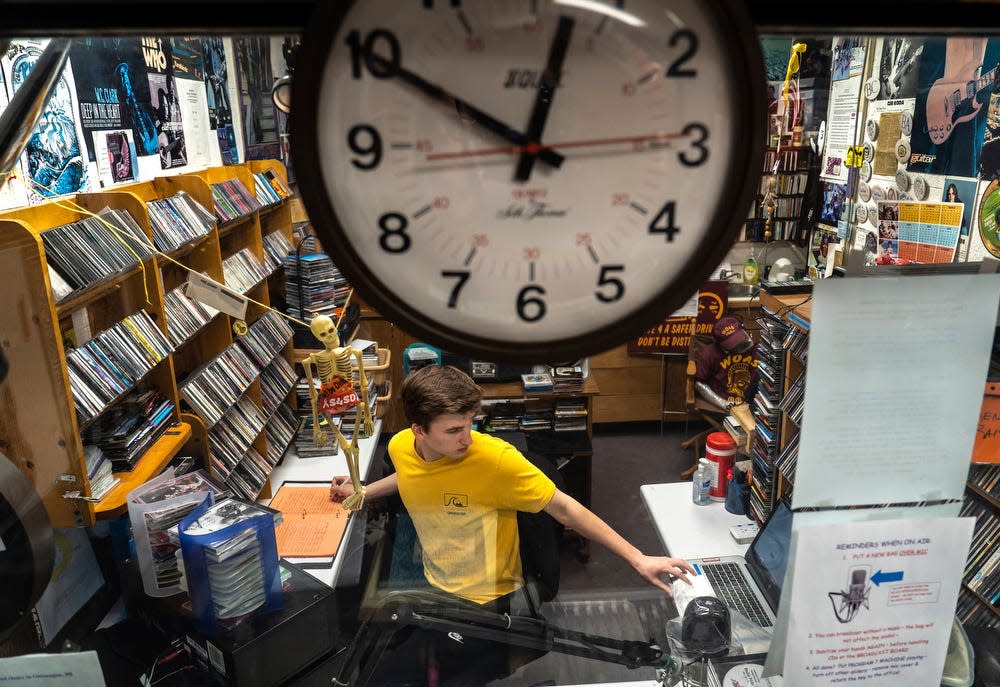
ONTONAGON — Tiny little radio station WOAS was just sitting at its frequency, minding its own business, when a bigger station came along and took away its spot on the dial.
“This guy reluctantly sent me an email last April, basically saying, ‘Oh, by the way, we bought up your frequency and you’re gonna have to find a new frequency,’ ” said Ken Raisanen, the 69-year-old manager of WOAS 88.5-FM, the student-run radio station that’s been broadcasting from the Ontonagon High School building in the western Upper Peninsula since 1978.
WOAS is very small — just 10 watts of broadcasting power, so faint it’ll dissolve into static on a car radio when a driver rounds the hills just outside of town. It’s one of only two radio stations in the village. Funding comes largely from two snack vending machines inside the school. Everyone who works there is a volunteer. And the format is usually whatever that afternoon’s high school DJ or that night’s village resident feels like playing.
By contrast, WHWL 95.7-FM has 10,000 times the broadcasting power of the school station. At 100 kilowatts of strength, and with 10 translator stations that carry its broadcasts even farther across the Upper Peninsula, the Marquette-based station boasts that its signal “covers the straits area and the northern tip of Lower Michigan, and our Sault Ste. Marie transmitter beams the good news of Jesus Christ north into Canada.” It’s funded by donations. And its programming is unvarying.
“Our format is a combination of Bible-teaching programs and traditional, conservative music,” the station notes. “The blend is a unique one, and has inspired many positive comments from loyal listeners.”
Almost two years ago, WHWL applied to the Federal Communications Commission for construction permits for two more stations — one of which will be in Rockland, right next door to Ontonagon. In February, the FCC approved the request, granting a license for a new station on 88.5 FM, the longtime home of WOAS. Now, the student-run station either needs to find itself a new place on the dial, or else go off the air.
“They said, ‘By the way, our consultant sent us a list of all these frequencies available for you that you can look at,' ” Raisanen said. “I said, ‘OK, then why are you taking 88.5? Why, when you sent me all the other frequencies that are available, why that one?' ” He said, ‘Our consultant says that’s the best one for us.' ’”
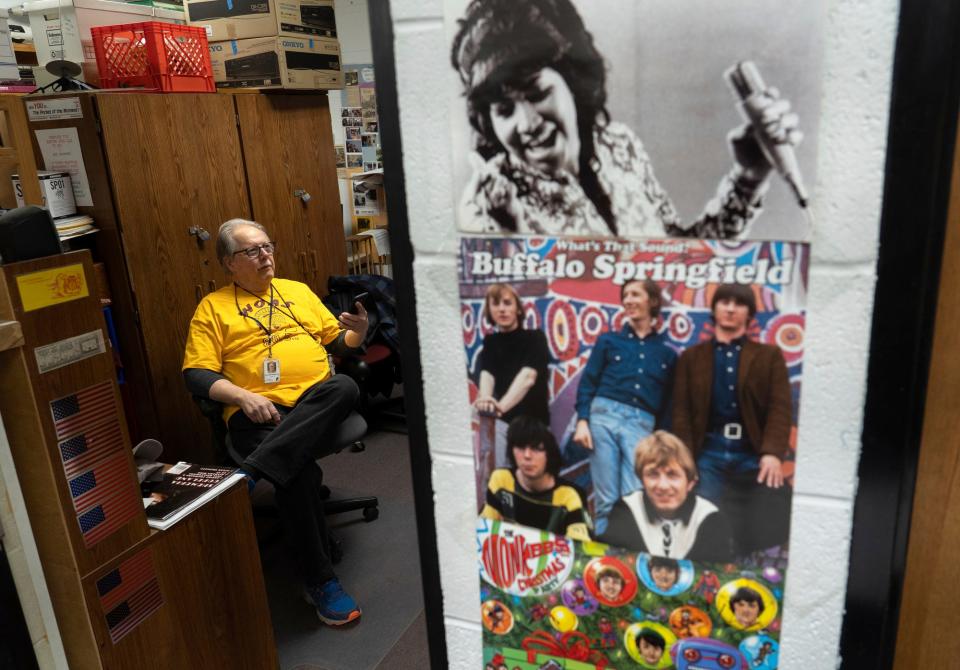

His station’s size is what made it vulnerable. WOAS is a Class D station, the lowest FCC classification for low-power, noncommercial radio stations, and these are deemed “unprotected” from other broadcasters, which can legally overpower its signal or simply apply to take over the station’s place on the dial. Thanks partly to this system, there are only about a dozen high school stations left in Michigan, and barely 200 nationwide.
The manager of WHWL, which is a Class A radio station, insists he never set out to displace someone else. His station, he said, needs to expand and they’re just following the rules set up by the FCC.
But that doesn’t make it any easier for the people at WOAS to swallow.
“Ontonagon has this long history of people in boardrooms in far-off places like New York and Cleveland and Boston and Chicago making decisions about the economy here, and it goes on today,” Raisanen said, referring to the village’s early years, when distant barons ran the town’s lumber and mining interests and controlled its future.
“This is just a smaller version of that,” he said. “It’s some guy sitting 120 miles away saying, ‘Hey we can take that.’ And they did.”
***
WOAS was founded just before Christmas 1978 by the librarian at Ontonagon High School, who thought it’d be nice to have a radio station in town, back when there were none. He rounded up some used equipment, outfitted a studio in a small backroom in the library and launched the station with two turntables and a microphone. These days, the station has upgraded to CD players and laptops, and can be heard on the radio, over the internet and as the background music at Pat’s Foods IGA on the outskirts of town.
Raisanen was a science teacher at the school, who also had his own oldies show during afternoons. When the station manager was promoted to another building in the district, Raisanen volunteered to take over to keep WOAS from folding. Twenty-five years later, long after retirement, he still comes in almost every day to help manage the station and teach new students how to be broadcasters.
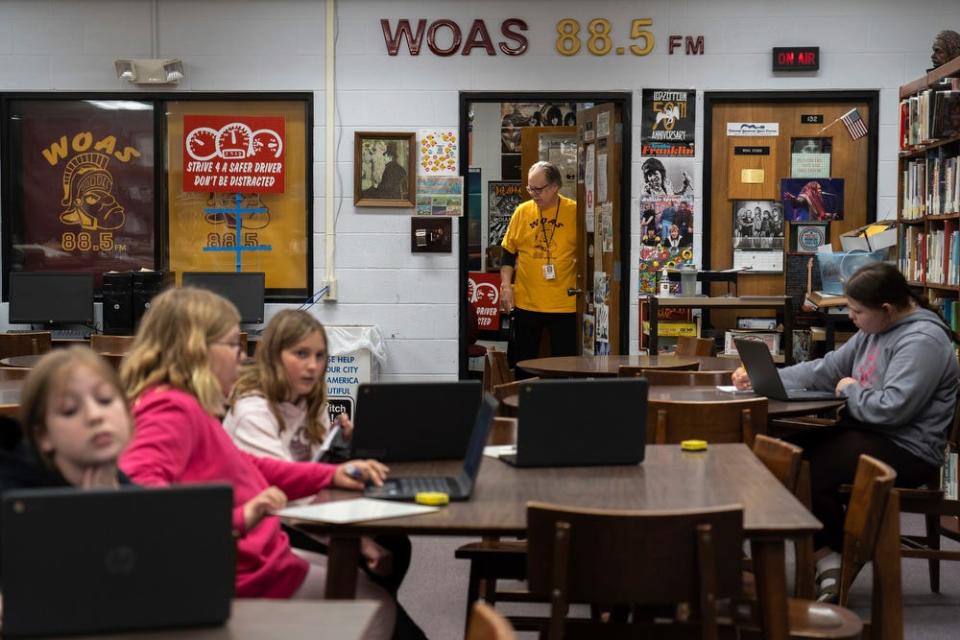
Even as the world has moved on to algorithms, playlists and preprogramming, he still loves the kind of old-fashioned radio that involves real people.
“To me, the fun part about radio is when they start talking about stuff or they get silly about something,” Raisanen said. “That’s why I’m always telling the kids, ‘You gotta do more than just play tunes. If you wanna just play tunes then I don’t need you. What I want is the human element. You gotta have a personality.’ And if you get the right two kids in there who start talking about stuff, it sucks you in. It’s funny to listen to when kids start talking about school and stuff. It’s a lot better than listening to CNN.”
More: Upper Peninsula man works to save historic club from dying
For decades, the afternoon slots have been filled by students. At night, to avoid dead air, shows were offered to locals who jumped at the chance to share their favorite music with their neighbors in town.
“I’ve always liked radio,” said Lee McCaffrey, 71, host of “Eclectic Fridays” on WOAS. He met Raisanen at the local animal shelter where both are volunteers. Raisanen told him the station had openings and offered him a time slot.
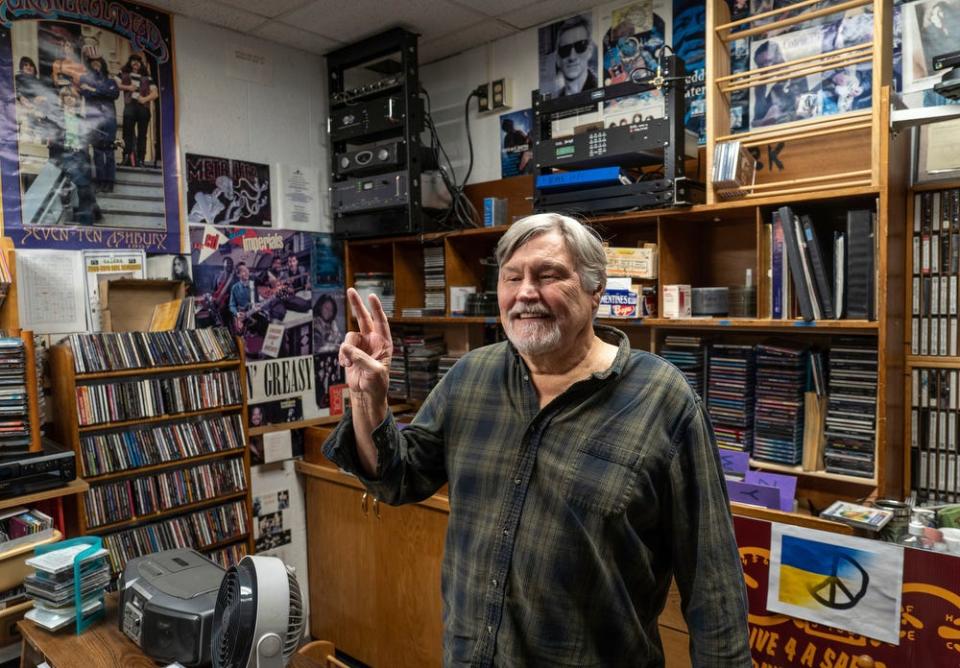
“Music was so big in our lives growing up, and we had some of the best music then,” McCaffery said. “And I say that on the air: ‘You know, you haven’t heard a lot of this stuff, but I just want to expose you to it.’ And everyone’s like, ‘Really? Who is that?’ I always give the name of the song, the group and also the album it’s on, like they used to do. You don’t have that anymore.”
The station has long faced challenges. In an era of tightening school budgets, funding has been intermittent. If an unexpected expense arises or a piece of equipment breaks, Raisanen has to either take up a collection, dig into his own pockets, or else make an appeal in the local newspaper where he writes an occasional column.
Then came the pandemic, when all the student DJs were learning remotely and the school building was empty. Raisanen and McCaffrey essentially kept the station on the air themselves, taking turns coming in and playing music. “There were no kids in school, and we didn’t want to just disappear,” Raisanen said. “He’d do a couple nights and I’d do the day programming. But it was weird having a student-run radio station and no students.”
And now comes the station’s biggest threat so far.
“It’s really strange, particularly when this isn’t a commercial entity,” said Jim Bradley, 75, the retired radio engineer who helped set up the station years ago. He still comes in when Raisanen needs technical help. “It’s a nonprofit, essentially, struggling from year to year to get by. I don’t get it.”
***
Andy Larsen says he knows what it’s like to be bumped from your spot on the radio dial. It happened to him before.
“There was a station that was increasing in power and it was on the first or second adjacent channel to ours, and so our translator frequency got bumped,” said Larsen. He’s the general manager of WHWL, the station that was granted the use of 88.5 by the FCC. “We were fortunate that we were able to just bump it up a notch on the dial, and we were back on the air. But it happens.”
WHWL 95.7-FM was founded in 1975 in Marquette. It’s the flagship station of the Gospel Opportunities Radio Network along with two other U.P. radio stations and 10 low-power translators, which copy a station’s signal onto another frequency, thereby spreading it a greater distance. Those translators, though, can be bumped from their frequency just like a Class D station can. WHWL wants to avoid that. That’s why it’s building the new station in Rockland so it can lock in a location on the FM dial.
More: A Black Civil War soldier's unmarked grave Up North finally gets a headstone
This wasn’t, Larsen said, a deliberate act of aggression. He said that 88.5 was chosen by a consultant hired by the station, and there are only so many spots on the FM dial, and noncommercial stations like his are further limited to the narrow range of 88.1-91.9. So when a Class A station wants a channel, the FCC says any unprotected, low-power stations that are in the way must move.
“WOAS-FM is a secondary service,” said Katie Gorscak, an FCC representative, in a statement. “Under our rules, all secondary service stations must accept interference from primary stations and may not cause interference to primary stations, even if the secondary station predates the primary station. … That means the new station will be entitled to cause interference to WOAS and WOAS may not cause interference to the new station. That is the longstanding nature of secondary services.”
In other words, if WOAS doesn’t move, WHWL can simply drown out the school station’s signal with its far greater strength.
Twenty years or so ago, when the FCC was trying to eliminate low-power Class D stations entirely, the agency recommended that WOAS buy a new transmitter, upgrade from the unprotected range and protect itself from this outcome. But Raisanen explained that the station had just been refurbished with a rare grant from the district, and that more money was unlikely to be forthcoming. Plus, he never imagined something like this could happen.
“I inherited the station. And me being the newbie at this, I didn’t realize that Class D is unprotected like this,” he admitted.
Larsen points out that he sent Raisanen a message informing him of the change, even though notification is not mandated by the FCC. And, he noted, he asked his industry consultant to send over a list of available frequencies that WOAS could switch to, which also wasn’t required. Plus, he said, he promised to hold off his station’s changeover as long as possible to give WOAS time to find a new home first.
“We just want to be a good neighbor,” Larsen said. “It’s unfortunate that they were on that frequency, but we do want to help them out. They’re only 10 watts, but it’s right in town, so they do serve that community, and so we want to make sure we help them stay on the air and do what they’re doing. But it’s just an industry thing. It is what it is.”
***
It was late morning. The students were in their classrooms. The hallways were quiet. The walls were lined with class photos going back to 1968. Each photo had fewer students pictured than the year before, a decline that eventually led all the schools in town to merge in response to the dwindling population. Streamers still hung from the ceiling of the cafeteria where prom had been held the week before.
Deep in the library, inside the booth of the radio station, the morning DJs began their show during their short break between classes.
“I’m a huge music person,” said senior Halle Floyd, 18, filling out the day’s log as she began her shift with Austin Razmus, 18. “I love listening to music, so now I get to come in here and do my own show my own way, and listen to my music and share it with everybody else. It’s a really cool thing that not a lot of people get to experience. To say that you had your own radio show in high school is a pretty cool thing to say, in my opinion.”
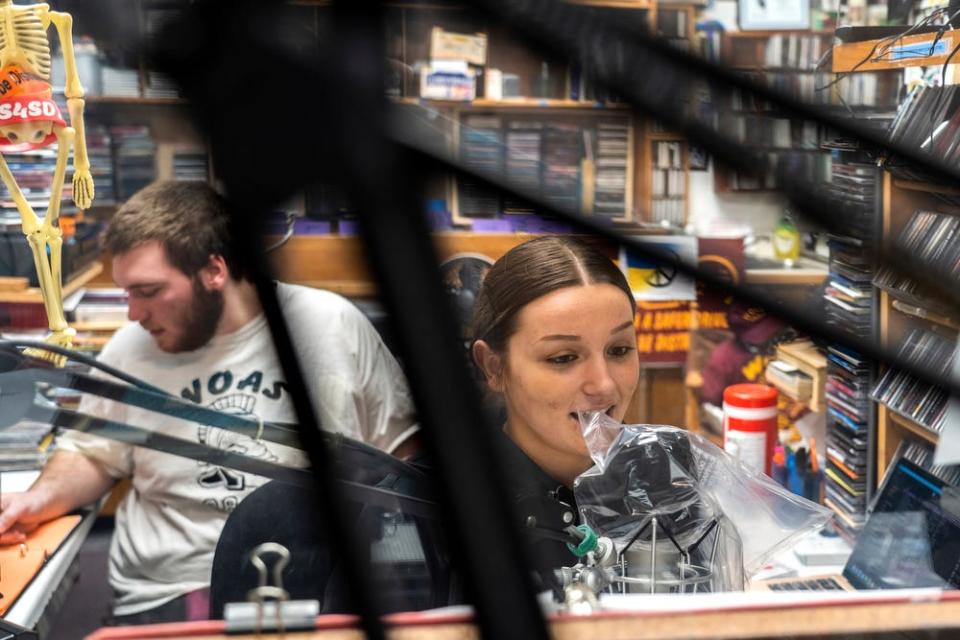

Pete Bowers, who created the annual High School Radio Day 13 years ago to draw attention to high school stations nationwide, said that even in an era dominated by streaming podcasts and music apps, there’s still a role for student-run radio stations like WOAS.
“Admittedly there’s a lot of options now, and that makes it a challenge. But what you’re not going to get on Spotify is a high school football game, or these students who are going on the air and talking about what’s going on in their community; events like a festival or something that’s happening at the school,” Bowers, who spent a career in broadcasting in metro Detroit, said. “That’s the one thing that you’re going to get not just on high school radio, but any kind of local radio station as they talk about and promote the things that are happening in their community.”
As the morning turned into afternoon, Raisanen sat in the school library, reading the local newspaper, listening to the kids run the station, but sticking around just in case he might be needed.
“The question I always get is, 'What’s your demographic? Do you know how many people listen?' ” he said. “We’ve never done a study like that, but I still run into people at the store who say, ‘Hey, you guys got that fixed up yet?’ Or we put out a fund appeal, and all of a sudden I’m getting money from Florida or from Minneapolis. I was corresponding with a drummer from Scotland for a while who had picked us up on the internet at some point in time or another. So we know people listen.”
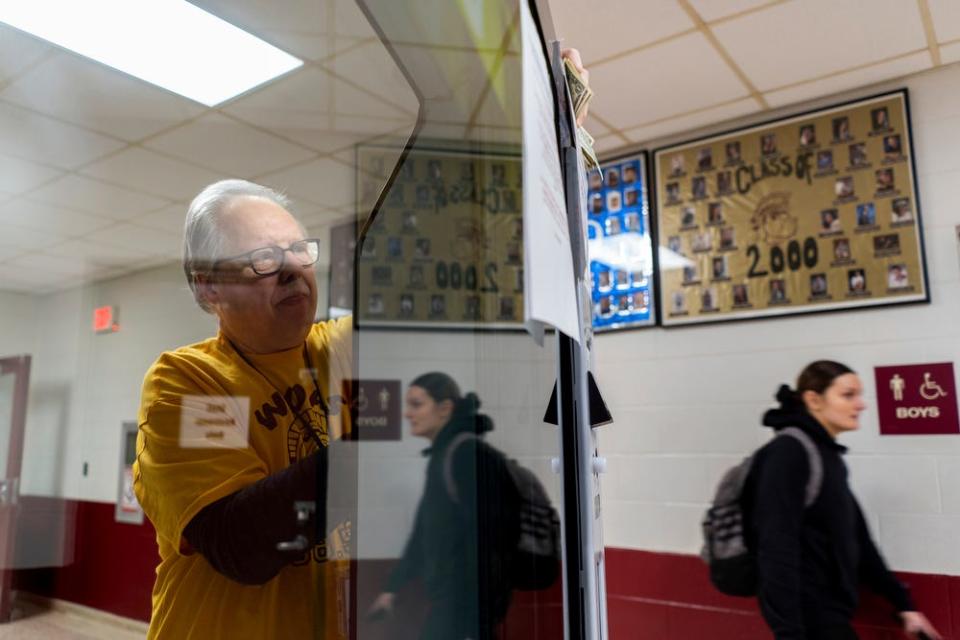
This spring, when he learned they’d lose their frequency, Raisanen mentioned in the local newspaper what happened, and noted that the station could use some donations to help keep it going. There was no official fundraiser. No GoFundMe either.
But word spread through town. People came up on the streets and handed him $10 or $20 bills. An anonymous resident gave him $1,000. Before long, he raised enough money to buy a new transmitter for the school this summer so the station can boost its signal strength to 100 watts, the minimum required by the FCC for an upgraded license. It would be a ticket out of the unprotected realm of the dial. It should prevent this kind of displacement from happening again. And it just might guarantee that WOAS remains one of the few student-run stations still broadcasting.
“We’ve got a 45-year legacy, and we’ll be back on the air,” Raisanen said. “And hopefully, 45 years from now, they’ll be talking about this in historical terms like, ‘Hey, remember back when that guy took our frequency?’ ”
John Carlisle writes about Michigan. His stories can be found at freep.com/carlisle. Contact him: jcarlisle@freepress.com. Follow him on Twitter @_johncarlisle, Facebook at johncarlisle.freep or on Instagram at johncarlislefreep.
This article originally appeared on Detroit Free Press: Frequency for U.P. high school radio station WOAS taken away

